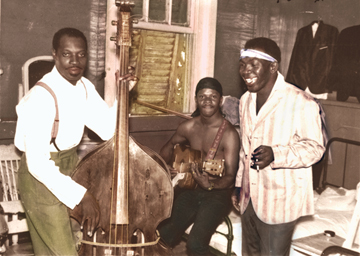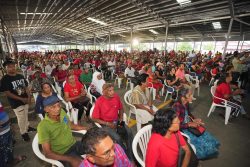By Geoffrey Dunn
And I was with them all,
When the sun and streets exploded,
And a city of clerks
turned a city of men.
—Martin Carter, “Black Friday 1962”
Behold the photograph: Three legendary calypsonians from Trinidad and Tobago—the Grandmaster Lord Kitchener, with his stand-up bass; the bare-chested, nearly defiant Lord Superior; the always effervescent Lord Melody—are holed up in a spare hotel room, rehearsing for the night’s performance. It is a rare photographic jewel in the historical archive of Caribbean calypso.
When my filmmaking partner, Michael Horne, and I came across the slightly rumpled black-and-white image in a box of memorabilia at Lord Superior’s home outside of Port-of-Spain six years ago, in February of 2002, we were absolutely delighted. It had previously been unpublished—giving to it the joy and spontaneity of discovery—but moreover we knew instantly that it would work perfectly into the film we were producing, Calypso Dreams, specifically as an illustration for a point in the film when Superior (aka Supie) describes Kitch playing a stand-up bass. And we would also use a close-up of the photo to illustrate the elusive Lord Melody when the Mighty Sparrow was discussing Melody’s charisma.
I jotted down the written notes on the margins of the photograph. It was not taken in Port-of-Spain or London or New York, all likely venues for the photo shoot, but in British Guiana, in 1962, a prophetic year in Caribbean politics—the year of the Cuban Missile Crisis—but little did I know of the significance of that year in respect to the history of Guyana and of the role the United States played in that history.
 What excited me about the photo was the way it captured, in an almost elegiac sense, the essence of calypso during that era, with three of its most celebrated performers. It had an absolutely delightful vibe to it, joyous and spontaneous, and you could almost hear the music in the room.
What excited me about the photo was the way it captured, in an almost elegiac sense, the essence of calypso during that era, with three of its most celebrated performers. It had an absolutely delightful vibe to it, joyous and spontaneous, and you could almost hear the music in the room.
Behold the photograph again. It would eventually appear twice in the completed version of Calypso Dreams, illuminating quite perfectly the narrative taking place on screen. But it does not appear quite the same way we found it.
The magic of digital video allows one to colorize a photo now, and we brought the image additional life by adding various hues to it, by filling in the details lost in the deterioration of Acetic acid and silver halides on fibre paper over the years. I have quite literally looked at this photo a thousand times or more in the editing room. Enjoyed it immensely. We even used it in advertisements and publicity for the film. But I never gave it a second look. By that I mean I had never reconsidered it, instead seeing it the same way every time I viewed it.
Then, in the fall of 2006, I was asked by a friend at the University of Toronto if we would make the film available for a special screening sponsored by the Caribbean Studies Program at U.T. I forwarded her some publicity materials, including the photo in question, told her it had been taken in 1962 in B.G. and she emailed me back a comment about the Demerara shutters in the photograph.
Demerara shutters?
And then I looked more closely at the shutters, comprehending immediately that they were special and unique to Guyana. I had never heard of the term before and looked it up on-line, discovering that the louvered window-cover cants out from the side of the building, leaving a shelf at the bottom. Before air-conditioning, a block of ice would be left on the shelf, cooling the incoming air. In the 19th Century, ice was imported into British Guiana on schooners arriving from Canada, and used in the windows. And so the observation gave the photo a new vitality.
I blew the photo up on my computer so that it was life-sized, and noticed that Kitch’s bass had been wrapped in rope to hold it together. And in the bottom left-hand corner of the photograph, there was another face that I had never noticed before, only partially revealed, of a man wearing sunglasses and combed-back hair.
It’s been said that a picture is worth a thousand words. That is illusory. A picture provides its audience with a two-dimensional conception of flesh and blood, perhaps, and also, perhaps, time and place. A photograph freezes life, and, by so doing, distorts it.
In this case, it takes more than a thousand words to describe the remarkable convergence— and convergences—of culture and politics and life itself that inform and give meaning to this image.
So behold the photograph yet again. Some friends enlarged the image on their computers in T&T to have Lord Superior identify the fourth person in the photograph. Supie, of course, had been there when the photo was taken, and he has held it in his possession for the last 45 years. He was convinced there were only three people in the photograph. But he too, was forced to take a second look. Finally he recognized the fourth person as Lord Coffee, a Guyanese calypsonian, and the recognition spurred further memories.
The next time I visited Trinidad, I interviewed Superior at his home in Dorrington Gardens, Diego Martin. Superior is not only a co-producer of Calypso Dreams, he is also a friend and mentor, but even closer, like family. Our conversation about calypso has now gone on for the better part of a decade.
Superior recalled that movie house proprietor and record producer Leslie Lucky-Samaroo, then owner of the Strand Cinema in Trinidad, had, in the aftermath of Carnival 1962, arranged for himself, Melody and Kitchener (then living in England) to travel to British Guiana in order to play at the Georgetown Strand Cinema, which his family also owned.
Lucky-Samaroo, now 75, and long retired from the music business, and even more recently, from the airline business, does not remember the tour. He was recording many of the musicians at the time under his family’s record label, including Kitch, who was still living in England at the time, and they held the RCA publishing franchise in the Caribbean. He does remember that recording and promoting calypsonians was a “difficult” task.
What Superior and Lucky-Samaroo agree upon is that the tour foreshadowed Kitch returning to the T&T Carnival the following year and the opening of the Calypso Revue at the Strand Theatre in downtown Port-of-Spain for the 1964 Carnival season, going head-to-head with Sparrow. “We had the cream of the crop,” Lucky-Samaroo remembers, “and it gave Sparrow a few fits.”
In its first year, the Revue had a brilliant cast. It produced four Calypso Monarch finalists that inaugural season—Kitch, Nap Hepburn, Bomber, and Blakie. Kitch won the Road March, and Bomber won the crown. Sparrow later cancelled his contract with Lucky-Samaroo and broke out on his own.
So this epoch journey to Georgetown was prelude to an historic moment in calypso—the longstanding competition between Kitch and Sparrow in the calypso tents of Trinidad and Tobago.
If Lucky-Samaroo has no memory of arranging the tour, Lord Superior has no recall of the political atmosphere in B.G. upon the calypso contingent’s arrival. What he does remember is a lot of bacchanal between Kitch and Melody. “People remember the sparring between Melody and Sparrow,” Supie recalls, “but it was equally fierce between Melody and Kitch.”
It is Superior’s memory that they stayed at the Hotel Woodbine, and that he and Kitch also performed at the hotel’s open-air bar-b-cue and bar called the Moonglow. A few evenings, Melo also sang. One night, Supie remembers, Melody called Kitch “a dog.”
“You callin’ me a dog, bwoy?” Kitch replied.
“Yeah, I call you a dog,” Melo retorted. And like so.
Finally, Kitch had enough of Melo’s insults. “Well de dog not singing tonight,” he stormed and walked off.
Supie smiles that mischievous smile of his at this memory. “I had to beg Kitch for quite a spell and get him to perform that night.”
Supie recalled even more serious tensions between two of the Guyanese calypsonians who performed at the Strand, Lord Sweet Dreams and the aforementioned Coffee.
Also on the bill that week in Georgetown was another Guyanese calypsonian, Lord Canary (Malcolm Corrica).
He, too, remembers the bacchanal between Sweet Dreams and Coffee.
“I remember it got so bad that Sweet Dreams chased after Coffee with a billiard cue,” Canaray recalled.
“Sweet Dreams was a most aggressive sort of fellow. He bused nearly everybody. Fortunately Coffee had a good sprint.”
I asked Supie if he remembered who had taken the photograph? He thought, perhaps, it was Melody’s wife, but he wasn’t certain.
Part 2 will be published in the July edition of Guyana Review









